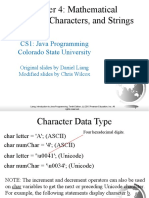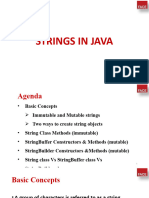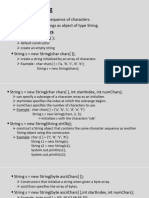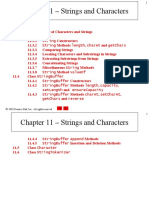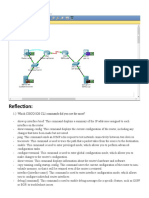Chapter 9:
Text Processing and More about Wrapper Classes
Starting Out with Java:
From Control Structures through Objects
Fifth Edition
by Tony Gaddis
�Chapter Topics
Chapter 9 discusses the following main topics:
Introduction to Wrapper Classes
Character Testing and Conversion with the Character Class
More String Methods
The StringBuilder Class
The StringTokenizer Class
Wrapper Classes for the Numeric Data Types
Focus on Problem Solving: The TestScoreReader
Class
2013 Pearson Education, Inc. Upper Saddle River, NJ. All Rights Reserved.
9-2
�Introduction to Wrapper Classes
Java provides 8 primitive data types.
They are called primitive because they are not created from
classes.
Java provides wrapper classes for all of the primitive data types.
A wrapper class is a class that is wrapped around a primitive
data type.
The wrapper classes are part of java.lang so to use them,
there is no import statement required.
2013 Pearson Education, Inc. Upper Saddle River, NJ. All Rights Reserved.
9-3
�Wrapper Classes
Wrapper classes allow you to create objects to
represent a primitive.
Wrapper classes are immutable, which means that once
you create an object, you cannot change the objects
value.
To get the value stored in an object you must call a
method.
Wrapper classes provide static methods that are very
useful
2013 Pearson Education, Inc. Upper Saddle River, NJ. All Rights Reserved.
9-4
�Character Testing and Conversion With The
Character Class
The Character class allows a char data type to
be wrapped in an object.
The Character class provides methods that
allow easy testing, processing, and conversion of
character data.
2013 Pearson Education, Inc. Upper Saddle River, NJ. All Rights Reserved.
9-5
�The Character Class
Method
Description
boolean isDigit(
char ch)
Returns true if the argument passed into ch is a
digit from 0 through 9. Otherwise returns false.
boolean isLetter(
char ch)
Returns true if the argument passed into ch is an
alphabetic letter. Otherwise returns false.
boolean isLetterOrDigit(
char ch)
Returns true if the character passed into ch
contains a digit (0 through 9) or an alphabetic
letter. Otherwise returns false.
boolean isLowerCase(
char ch)
Returns true if the argument passed into ch is a
lowercase letter. Otherwise returns false.
boolean isUpperCase(
char ch)
Returns true if the argument passed into ch is an
uppercase letter. Otherwise returns false.
boolean isSpaceChar(
char ch)
Returns true if the argument passed into ch is a
space character. Otherwise returns false.
2013 Pearson Education, Inc. Upper Saddle River, NJ. All Rights Reserved.
9-6
�Character Testing and Conversion
With The Character Class
Example:
CharacterTest.java
CustomerNumber.java
The Character class provides two methods that will
change the case of a character.
Method
Description
char toLowerCase(
char ch)
Returns the lowercase equivalent of the
argument passed to ch.
char toUpperCase(
char ch)
Returns the uppercase equivalent of the
argument passed to ch.
See example: CircleArea.java
2013 Pearson Education, Inc. Upper Saddle River, NJ. All Rights Reserved.
9-7
�Substrings
The String class provides several methods that search for a
string inside of a string.
A substring is a string that is part of another string.
Some of the substring searching methods provided by the
String class:
boolean startsWith(String str)
boolean endsWith(String str)
boolean regionMatches(int start, String str, int start2,
int n)
boolean regionMatches(boolean ignoreCase, int start,
String str, int start2, int n)
2013 Pearson Education, Inc. Upper Saddle River, NJ. All Rights Reserved.
9-8
�Searching Strings
The startsWith method determines whether a
string begins with a specified substring.
String str = "Four score and seven years ago";
if (str.startsWith("Four"))
System.out.println("The string starts with Four.");
else
System.out.println("The string does not start with Four.");
str.startsWith("Four") returns true because
str does begin with Four.
startsWith is a case sensitive comparison.
2013 Pearson Education, Inc. Upper Saddle River, NJ. All Rights Reserved.
9-9
�Searching Strings
The endsWith method determines whether a string
ends with a specified substring.
String str = "Four score and seven years ago";
if (str.endsWith("ago"))
System.out.println("The string ends with ago.");
else
System.out.println("The string does not end with ago.");
The endsWith method also performs a case sensitive
comparison.
Example: PersonSearch.java
2013 Pearson Education, Inc. Upper Saddle River, NJ. All Rights Reserved.
9-10
�Searching Strings
The String class provides methods that will if
specified regions of two strings match.
regionMatches(int start, String str, int start2,
int n)
returns true if the specified regions match or false if they
dont
Case sensitive comparison
regionMatches(boolean ignoreCase, int start,
String str, int start2, int n)
If ignoreCase is true, it performs case insensitive
comparison
2013 Pearson Education, Inc. Upper Saddle River, NJ. All Rights Reserved.
9-11
�Searching Strings
The String class also provides methods that will
locate the position of a substring.
indexOf
returns the first location of a substring or character in the
calling String Object.
lastIndexOf
returns the last location of a substring or character in the
calling String Object.
2013 Pearson Education, Inc. Upper Saddle River, NJ. All Rights Reserved.
9-12
�Searching Strings
String str = "Four score and seven years ago";
int first, last;
first = str.indexOf('r');
last = str.lastIndexOf('r');
System.out.println("The letter r first appears at "
+ "position " + first);
System.out.println("The letter r last appears at "
+ "position " + last);
String str = "and a one and a two and a three";
int position;
System.out.println("The word and appears at the "
+ "following locations.");
position = str.indexOf("and");
while (position != -1)
{
System.out.println(position);
position = str.indexOf("and", position + 1);
}
2013 Pearson Education, Inc. Upper Saddle River, NJ. All Rights Reserved.
9-13
�String Methods For Getting Character
Or 9-4 on
See Table
page 574.
Substring Location
2013 Pearson Education, Inc. Upper Saddle River, NJ. All Rights Reserved.
9-14
�String Methods For Getting Character
Or 9-4 on
See Table
page 574.
Substring Location
2013 Pearson Education, Inc. Upper Saddle River, NJ. All Rights Reserved.
9-15
�Extracting Substrings
The String class provides methods to extract
substrings in a String object.
The substring method returns a substring beginning
at a start location and an optional ending location.
String fullName = "Cynthia Susan Smith";
String lastName = fullName.substring(14);
System.out.println("The full name is "
+ fullName);
System.out.println("The last name is "
+ lastName);
2013 Pearson Education, Inc. Upper Saddle River, NJ. All Rights Reserved.
9-16
�Extracting Substrings
The fullName variable holds
the address of a String object.
Address
Cynthia Susan Smith
The lastName variable holds
the address of a String object.
Address
Smith
2013 Pearson Education, Inc. Upper Saddle River, NJ. All Rights Reserved.
9-17
�Extracting Characters to Arrays
The String class provides methods to extract
substrings in a String object and store them in
char arrays.
getChars
Stores a substring in a char array
toCharArray
Returns the String objects contents in an array of char values.
Example: StringAnalyzer.java
2013 Pearson Education, Inc. Upper Saddle River, NJ. All Rights Reserved.
9-18
�Returning Modified Strings
The String class provides methods to return
modified String objects.
concat
Returns a String object that is the concatenation of two String
objects.
replace
Returns a String object with all occurrences of one character
being replaced by another character.
trim
Returns a String object with all leading and trailing whitespace
characters removed.
2013 Pearson Education, Inc. Upper Saddle River, NJ. All Rights Reserved.
9-19
�The valueOf Methods
The String class provides several overloaded valueOf
methods.
They return a String object representation of
a primitive value or
a character array.
String.valueOf(true) will return "true".
String.valueOf(5.0) will return "5.0".
String.valueOf(C) will return "C".
2013 Pearson Education, Inc. Upper Saddle River, NJ. All Rights Reserved.
9-20
�The valueOf Methods
boolean b = true;
char [] letters = { 'a', 'b', 'c', 'd', 'e' };
double d = 2.4981567;
int i = 7;
System.out.println(String.valueOf(b));
System.out.println(String.valueOf(letters));
System.out.println(String.valueOf(letters, 1, 3));
System.out.println(String.valueOf(d));
System.out.println(String.valueOf(i));
Produces the following output:
true
abcde
bcd
2.4981567
7
2013 Pearson Education, Inc. Upper Saddle River, NJ. All Rights Reserved.
9-21
�The StringBuilder Class
The StringBuilder class is similar to the String class.
However, you may change the contents of StringBuilder
objects.
You can change specific characters,
insert characters,
delete characters, and
perform other operations.
A StringBuilder object will grow or shrink in size, as
needed, to accommodate the changes.
2013 Pearson Education, Inc. Upper Saddle River, NJ. All Rights Reserved.
9-22
�StringBuilder Constructors
StringBuilder()
This constructor gives the object enough storage space to hold 16
characters.
StringBuilder(int length)
This constructor gives the object enough storage space to hold
length characters.
StringBuilder(String str)
This constructor initializes the object with the string in str.
The object will have at least enough storage space to hold the string in
str.
2013 Pearson Education, Inc. Upper Saddle River, NJ. All Rights Reserved.
9-23
�Other StringBuilder Methods
The String and StringBuilder also have common
methods:
char charAt(int position)
void getChars(int start, int end,
char[] array, int arrayStart)
int indexOf(String str)
int indexOf(String str, int start)
int lastIndexOf(String str)
int lastIndexOf(String str, int start)
int length()
String substring(int start)
String substring(int start, int end)
2013 Pearson Education, Inc. Upper Saddle River, NJ. All Rights Reserved.
9-24
�Appending to a StringBuilder Object
The StringBuilder class has several overloaded versions
of a method named append.
They append a string representation of their argument to the
calling objects current contents.
The general form of the append method is:
object.append(item);
where object is an instance of the StringBuilder
class and item is:
a primitive literal or variable.
a char array, or
a String literal or object.
2013 Pearson Education, Inc. Upper Saddle River, NJ. All Rights Reserved.
9-25
�Appending to a StringBuilder Object
After the append method is called, a string representation of
item will be appended to objects contents.
StringBuilder str = new StringBuilder();
str.append("We sold ");
str.append(12);
str.append(" doughnuts for $");
str.append(15.95);
System.out.println(str);
This code will produce the following output:
We sold 12 doughnuts for $15.95
2013 Pearson Education, Inc. Upper Saddle River, NJ. All Rights Reserved.
9-26
�Appending to a StringBuilder Object
The StringBuilder class also has several overloaded
versions of a method named insert
These methods accept two arguments:
an int that specifies the position to begin insertion, and
the value to be inserted.
The value to be inserted may be
a primitive literal or variable.
a char array, or
a String literal or object.
2013 Pearson Education, Inc. Upper Saddle River, NJ. All Rights Reserved.
9-27
�Appending to a StringBuilder Object
The general form of a typical call to the insert method.
object.insert(start, item);
where object is an instance of the StringBuilder
class, start is the insertion location, and item is:
a primitive literal or variable.
a char array, or
a String literal or object.
Example:
Telephone.java
TelephoneTester.java
2013 Pearson Education, Inc. Upper Saddle River, NJ. All Rights Reserved.
9-28
�Replacing a Substring in a StringBuilder Object
The StringBuilder class has a replace method that
replaces a specified substring with a string.
The general form of a call to the method:
object.replace(start, end, str);
start is an int that specifies the starting position of a substring in
the calling object, and
end is an int that specifies the ending position of the substring.
(The starting position is included in the substring, but the ending
position is not.)
The str parameter is a String object.
After the method executes, the substring will be replaced
with str.
2013 Pearson Education, Inc. Upper Saddle River, NJ. All Rights Reserved.
9-29
�Replacing a Substring in a StringBuilder Object
The replace method in this code replaces the word
Chicago with New York.
StringBuilder str = new StringBuilder(
"We moved from Chicago to Atlanta.");
str.replace(14, 21, "New York");
System.out.println(str);
The code will produce the following output:
We moved from New York to Atlanta.
2013 Pearson Education, Inc. Upper Saddle River, NJ. All Rights Reserved.
9-30
�Other StringBuilder Methods
The StringBuilder class also provides methods to set and
delete characters in an object.
StringBuilder str = new StringBuilder(
"I ate 100 blueberries!");
// Display the StringBuilder object.
System.out.println(str);
// Delete the '0'.
str.deleteCharAt(8);
// Delete "blue".
str.delete(9, 13);
// Display the StringBuilder object.
System.out.println(str);
// Change the '1' to '5'
str.setCharAt(6, '5');
// Display the StringBuilder object.
System.out.println(str);
2013 Pearson Education, Inc. Upper Saddle River, NJ. All Rights Reserved.
9-31
�Other StringBuilder Methods
The toString method
You can call a StringBuilder's toString
method to convert that StringBuilder object to
a regular String
StringBuilder strb = new StringBuilder("This is a test.");
String str = strb.toString();
2013 Pearson Education, Inc. Upper Saddle River, NJ. All Rights Reserved.
�The StringTokenizer Class
The StringTokenizer class breaks a string down
into its components, which are called tokens.
Tokens are a series of words or other items of data
separated by spaces or other characters.
"peach raspberry strawberry vanilla"
This string contains the following four tokens: peach,
raspberry, strawberry, and vanilla.
2013 Pearson Education, Inc. Upper Saddle River, NJ. All Rights Reserved.
9-33
�The StringTokenizer Class
The character that separates tokens is a delimiter.
"17;92;81;12;46;5"
This string contains the following tokens: 17, 92, 81,
12, 46, and 5 that are delimited by semi-colons.
Some programming problems require you to process a
string that contains a list of items.
2013 Pearson Education, Inc. Upper Saddle River, NJ. All Rights Reserved.
9-34
�The StringTokenizer Class
For example,
a date:
"4-2-2010"
an operating system pathname,
/home/rsullivan/data
The process of breaking a string into tokens is known as
tokenizing.
The Java API provides the StringTokenizer class that
allows you to tokenize a string.
The following import statement must be used in any class
that uses it:
import java.util.StringTokenizer;
2013 Pearson Education, Inc. Upper Saddle River, NJ. All Rights Reserved.
9-35
�StringTokenizer Constructors
Constructor
Description
StringTokenizer(
String str)
The string to be tokenized is passed into str.
Whitespace characters (space, tab, and newline)
are used as delimiters.
StringTokenizer(
String str,
String delimiters)
The string to be tokenized is passed into str.
The characters in delimiters will be used as
delimiters.
StringTokenizer(
String str,
String delimiters,
Boolean returnDelimeters)
The string to be tokenized is passed into str.
The characters in delimiters will be used as
delimiters. If the returnDelimiters parameter is
set to true, the delimiters will be included as
tokens. If this parameter is set to false, the
delimiters will not be included as tokens.
2013 Pearson Education, Inc. Upper Saddle River, NJ. All Rights Reserved.
9-36
�Creating StringTokenizer Objects
To create a StringTokenizer object with the default
delimiters (whitespace characters):
StringTokenizer strTokenizer =
new StringTokenizer("2 4 6 8");
To create a StringTokenizer object with the hyphen
character as a delimiter:
StringTokenizer strTokenizer =
new StringTokenizer("8-14-2004", "-");
To create a StringTokenizer object with the hyphen
character as a delimiter, returning hyphen characters as
tokens as well:
StringTokenizer strTokenizer =
new StringTokenizer("8-14-2004", "-", true);
2013 Pearson Education, Inc. Upper Saddle River, NJ. All Rights Reserved.
9-37
�StringTokenizer Methods
The StringTokenizer class provides:
countTokens
Count the remaining tokens in the string.
hasMoreTokens
Are there any more tokens to extract?
nextToken
Returns the next token in the string.
Throws a NoSuchElementException if there are no more
tokens in the string.
2013 Pearson Education, Inc. Upper Saddle River, NJ. All Rights Reserved.
9-38
�Extracting Tokens
Loops are often used to extract tokens from a string.
StringTokenizer strTokenizer =
new StringTokenizer("One Two Three");
while (strTokenizer.hasMoreTokens())
{
System.out.println(strTokenizer.nextToken());
}
This code will produce the following output:
One
Two
Three
Examples: DateComponent.java, DateTester.java
2013 Pearson Education, Inc. Upper Saddle River, NJ. All Rights Reserved.
9-39
�Multiple Delimiters
The default delimiters for the StringTokenizer class
are the whitespace characters.
\n\r\t\b\f
Other multiple characters can be used as delimiters in the
same string.
joe@gaddisbooks.com
This string uses two delimiters: @ and .
If non-default delimiters are used
The String class trim method should be used on user
input strings to avoid having whitespace become part of
the last token.
2013 Pearson Education, Inc. Upper Saddle River, NJ. All Rights Reserved.
9-40
�Multiple Delimiters
To extract the tokens from this string we must specify both
characters as delimiters to the constructor.
StringTokenizer strTokenizer =
new StringTokenizer("joe@gaddisbooks.com", "@.");
while (strTokenizer.hasMoreTokens())
{
System.out.println(strTokenizer.nextToken());
}
This code will produce the following output:
joe
gaddisbooks
com
2013 Pearson Education, Inc. Upper Saddle River, NJ. All Rights Reserved.
9-41
�The String Class split Method
Tokenizes a String object and returns an array of String
objects
Each array element is one token.
// Create a String to tokenize.
String str = "one two three four";
// Get the tokens from the string.
String[] tokens = str.split(" ");
// Display each token.
for (String s : tokens)
System.out.println(s);
This code will produce the following output:
one
two
three
four
2013 Pearson Education, Inc. Upper Saddle River, NJ. All Rights Reserved.
9-42
�Numeric Data Type Wrappers
Java provides wrapper classes for all of the
primitive data types.
The numeric primitive wrapper classes are:
Wrapper
Class
Numeric Primitive
Type It Applies To
Byte
byte
Double
double
Float
float
Integer
int
Long
long
Short
short
2013 Pearson Education, Inc. Upper Saddle River, NJ. All Rights Reserved.
9-43
�Creating a Wrapper Object
To create objects from these wrapper classes, you can
pass a value to the constructor:
Integer number = new Integer(7);
You can also assign a primitive value to a wrapper
class object:
Integer number;
number = 7;
2013 Pearson Education, Inc. Upper Saddle River, NJ. All Rights Reserved.
9-44
�The Parse Methods
Recall from Chapter 2, we converted String input (from
JOptionPane) into numbers. Any String containing a
number, such as 127.89, can be converted to a numeric data
type.
Each of the numeric wrapper classes has a static method that
converts a string to a number.
The Integer class has a method that converts a String
to an int,
The Double class has a method that converts a String to
a double,
etc.
These methods are known as parse methods because their
names begin with the word parse.
2013 Pearson Education, Inc. Upper Saddle River, NJ. All Rights Reserved.
9-45
�The Parse Methods
// Store 1 in bVar.
byte bVar = Byte.parseByte("1");
// Store 2599 in iVar.
int iVar = Integer.parseInt("2599");
// Store 10 in sVar.
short sVar = Short.parseShort("10");
// Store 15908 in lVar.
long lVar = Long.parseLong("15908");
// Store 12.3 in fVar.
float fVar = Float.parseFloat("12.3");
// Store 7945.6 in dVar.
double dVar = Double.parseDouble("7945.6");
The parse methods all throw a NumberFormatException
if the String object does not represent a numeric value.
2013 Pearson Education, Inc. Upper Saddle River, NJ. All Rights Reserved.
9-46
�The toString Methods
Each of the numeric wrapper classes has a static
toString method that converts a number to a string.
The method accepts the number as its argument and
returns a string representation of that number.
int i = 12;
double d = 14.95;
String str1 = Integer.toString(i);
String str2 = Double.toString(d);
2013 Pearson Education, Inc. Upper Saddle River, NJ. All Rights Reserved.
9-47
�The toBinaryString, toHexString, and
toOctalString Methods
The Integer and Long classes have three
additional methods:
toBinaryString, toHexString, and
toOctalString
int number = 14;
System.out.println(Integer.toBinaryString(number));
System.out.println(Integer.toHexString(number));
System.out.println(Integer.toOctalString(number));
This code will produce the following output:
1110
e
16
2013 Pearson Education, Inc. Upper Saddle River, NJ. All Rights Reserved.
9-48
�MIN_VALUE and MAX_VALUE
The numeric wrapper classes each have a set of static final
variables
MIN_VALUE and
MAX_VALUE.
These variables hold the minimum and maximum values for a
particular data type.
System.out.println("The minimum value for an "
+ "int is "
+ Integer.MIN_VALUE);
System.out.println("The maximum value for an "
+ "int is "
+ Integer.MAX_VALUE);
2013 Pearson Education, Inc. Upper Saddle River, NJ. All Rights Reserved.
9-49
�Autoboxing and Unboxing
You can declare a wrapper class variable and assign a value:
Integer number;
number = 7;
You nay think this is an error, but because number is a wrapper
class variable, autoboxing occurs.
Unboxing does the opposite with wrapper class variables:
Integer myInt = 5;
int primitiveNumber;
primitiveNumber = myInt;
// Autoboxes the value 5
// unboxing
2013 Pearson Education, Inc. Upper Saddle River, NJ. All Rights Reserved.
9-50
�Autoboxing and Unboxing
You rarely need to declare numeric wrapper class objects,
but they can be useful when you need to work with
primitives in a context where primitives are not permitted
Recall the ArrayList class, which works only with
objects.
ArrayList<int> list =
new ArrayList<int>();
// Error!
ArrayList<Integer> list =
new ArrayList<Integer>(); // OK!
Autoboxing and unboxing allow you to conveniently use
ArrayLists with primitives.
2013 Pearson Education, Inc. Upper Saddle River, NJ. All Rights Reserved.
9-51
�Problem Solving
Dr. Harrison keeps student scores in an Excel file.
This can be exported as a comma separated text file.
Each students data will be on one line. We want to
write a Java program that will find the average for
each student. (The number of students changes each
year.)
Solution: TestScoreReader.java, TestAverages.java
2013 Pearson Education, Inc. Upper Saddle River, NJ. All Rights Reserved.
9-52

















